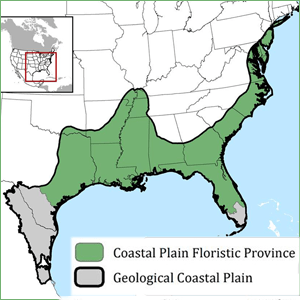We mistakenly presume that the global priorities for species conservation will always be distant, in someone else’s backyard. That illusion has now been firmly dismissed. Conservation International has declared Global Biodiversity Hotspot no. 36, a new addition to the global portfolio of areas possessing an extraordinary diversity of animal, fungi and plant species and simultaneously facing high risk of destruction. The new hotspot, the North American Coastal Plain Hotspot (NACP), stretches from Massachusetts south to the Florida Keys and west to Tamaulipas, Mexico.

The North American Coastal Plain is a global biodiversity hotspot stretching from the Florida Keys north to Massachusetts. Photo courtesy of Critical Ecosystem Partnership Fund.
Our local Florida habitats now join a global portfolio that includes the Atlantic Forests of Brazil, Madagascar, the Mediterranean Basin, the South African Cape and the Caucasus. As Floridians, we live, drive, work, garden, study, farm and shop in a globally important biodiversity hotspot. Our threatened species now have a global context and our work as conservationists has an enhanced global relevance.
The NACP contains 6170 native vascular plant types. Of these, nearly 29 percent are endemic, or unique, to the new hotspot. This includes over 50 endemic plant genera and a range of monotypic genera.
The hotspot system originally devised by environmental scientists Russ Mittermeier and Norman Myers has profoundly influenced the science and delivery of conservation. It was developed as a tool to identify those precious parts of the world that hold irreplaceable biodiversity. It has proved successful in galvanizing attention and directing funds to a diverse set of landscapes around the world. Using largely botanical inventory and floristic analysis, scientists calculated the previously unrecognized diversity and uniqueness of the NACP, a hotspot hidden in plain sight.
The designation of a hotspot, however is not an academic appellation, it is a mechanism for delivering conservation. Over the last 150 years, the NACP hotspot has suffered extinctions — the Ivory Billed woodpecker no longer haunts the old- growth cypress forests, the endemicFranklinia tree survives only in cultivation, and the dusky seaside sparrow has been lost. The Florida Grasshopper Sparrow may follow them to extinction.
In South Florida, we have some extraordinary habitats, including the sub-tropical hammocks in the Florida Keys, the Pine Rocklands (one of North America’s most threatened habitats), and the Florida scrub. Now each piece of destroyed habitat and each extinction is a global issue, and it is up to us whether we become a case study in degrading a biodiversity hotspot or a case study in restoring a hotspot. Each extinction is both the loss of a global asset but also an irreplaceable erosion of regional identity.
FIU has an extraordinary cadre of biologists, ecologists, hydrologists and conservation biologists who are already helping restore the Everglades and recover threatened plant and animal species. Two conservation institutes have been established at FIU — the International Center for Tropical Botany, a partnership with the National Tropical Botanical Garden, and the Tropical Conservation Institute, a partnership with the Rare Species Conservatory Foundation.
We are working to solve a number of challenges, including the opportunity to develop science-based conservation tools and techniques that can be tested in Florida and applied globally, as well as training the next generation of conservationists. Our work is part of a larger global initiative. Not only are we working in the NACP biodiversity hotspot, we are part of a global initiative to conserve life in all its extraordinary diversity, uniqueness and abundance.
About the author:
Mike Maunder, Ph.D.
Associate Dean of Research Engagement, College of Arts, Sciences & Education Interim Director, The Kampong
Associate Professor, Department of Biological Sciences
Florida International University












